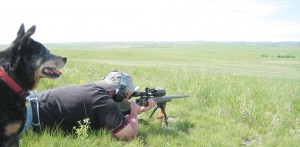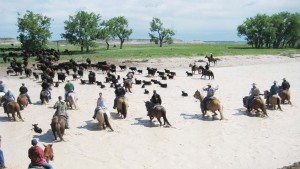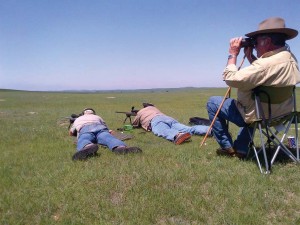by John Markwell | Contributing Editor
This article was originally scheduled for publication in the Varmint Hunter magazine before they closed their doors. We thought TGM readers might find it to be an interesting look at a summer’s varmint shooting.
Don, Jim and I shot south of the Badlands of South Dakota on June 12, 2013. We drove around checking out a few places but ended up at the town we shot two days earlier. Jim and Don really “got into ’em”; a classic example of being willing to get away from the truck. Maggie, my Heeler dog, and I had a great afternoon. I took a pocketful of ammo for the Spartan Walkabout, and went out to move some cows so Don and Jim could shoot. I shot 49 rounds (all I took) off of sticks and hit 42 out of 49 prairie dogs.
For going to new country, the shooting had been pretty good. But, this yarn is not all about the shooting.
I am admittedly an extremely lucky guy. For several years now, I’ve been able to hit the road for an extended period of time to pursue varmints in the western US. This has given me the time and freedom to extensively use some different firearms and other gear, under field conditions for articles. And it has opened opportunities to see new country and meet many new folks. Maggie and I have had some seriously grand adventures pursuing varmints. However, being on the road and chasing varmints is not all about the shooting, or the guns, or the gear. Sometimes it’s the “other stuff” that truly makes a trip memorable.

The author’s buddy Jim K. reaching out on the prairie as the author’s Heeler dog, Maggie, does the spotting.
In early May that year, I called Jack Gully in South Dakota about some possible leads on places to shoot. My shooting buddies, Don and Jim, didn’t want to drive all the way to Montana so we decided to check out southern SD. I hadn’t shot the White River/Conata Basin country since the late 1970s or early ’80s (pre-ferret days). In recent years, I have been linking up with another bunch of guys in northern SD the week after Don Duff and crew usually came to Montana. I didn’t want to encroach on the areas Rick Miller’s crew shot since they were due to show up a week after Don and Jim
So, scoping out some new country seemed like a good idea. Jack Gully is a good hand, a leather maker by trade (chaps, chinks and holsters) and a damned good cook. He told me to hook up with him in Newell and that he could probably point us to some good shooting. Little did I know what would follow and how it would all play out.
I arrived in SD in early June, a bit more before my friends. After a day or so spent with Jack, he invited me to help him barbecue food for the annual Sporting Arms and Ammunition Institute (SAAMI) meeting that was being hosted by the Cor-Bon ammunition folks at their new training facility in Sturgis. Jack, Irv Stone of BarSto barrels, and I spent an evening and a day cooking buffalo and serving food to some of the most influential folks in the shooting industry. This was fun and interesting to say the least. It also provided an opportunity to meet many of the folks who work for Cor-Bon and know the area well (see where this is going?). They in turn, directed me on to some areas for prairie dog shooting. The barbecue was some serious but fun work and proved to be worth the time invested.

View from the back of a horse. Driving 450 pairs across the White River in South Dakota. This is a part of American culture that few get to experience.
And then Jack asked me if I could ride a horse and if I would like to go to a branding? Not knowing what to expect, my answer was yes, hell yes.
The next Saturday, we rolled up to the corrals on the O’Rourke Ranch where there were more horses and trailers than there are in our entire county home in West Virginia. This was obviously a very big deal. On a nice little mare, provided for me by Jack, I joined the 40-plus riders. We crossed the White River and headed out to a big pasture (11+ sections) in search of 450 cow/calf pairs. The riders were mostly friends, neighbors and relatives and this was just one of many brandings that take place every year in the area south of the Badlands. These folks all pitch in to help each other gather the stock and brand the calves. Brandings are as much a social event as anything and are great fun. But they are taken very seriously.
It took several hours to gather the cattle and drive them north across the river. The few dry cows were sorted out and the rest of the cows and calves were driven into the pens where they were then separated. The calves were split up into two different pens, each of which was manned by a considerable crew of folks. Each calf was then roped, taken down, and stretched out by two folks. Both guys and gals worked in the pens and even the kids took part. It was truly a family affair.
The calves were castrated on the spot, branded, ear marked, and vaccinated and then kicked out to the waiting mother cows. To the uninitiated, the whole process appears to be chaotic but each person present has a job (I ear-marked with a tool much like an oversized paper punch) and the process is actually quite efficient. Even with the frequent breaks for cold beverages, the 450 calves were all easily worked by day’s end. The end of the branding was punctuated by a big feed and much socializing.
After ear-marking calves all afternoon (and getting a good poke in the head by a vaccinating needle), I had the opportunity to chat with many of the folks present about lots of things, including the shooting possibilities in the area. And then Jack said we were going to another branding the next day and that he was cooking for it!
Establishing “bona fides.”
Now my pal Don Duff has always been a horse guy. He even rode a bit of rodeo in his younger days. I knew that he and Jim were on the road coming to South Dakota, so I made a quick call and told Don that they needed to meet Jack and I by 10 a.m. the next day if he wanted to ride out and gather cows and take part in the branding. To make a long story short, Don and Jim drove hard and made it in time for us to get to the branding on Sunday. Don rode out to gather cows in the company of Jack and his wife Kelly, while I watched the meat cook. Jim helped with sprucing up the grounds of the ranch house for the barbecue. The scenario was much the same as the day before with many of the same folks in attendance. The calves at this second branding were all roped and worked with plenty of daylight left for chowing down and socializing. Being with Jack and being willing and able to contribute to the branding stood us in pretty good stead.
Compared to working cattle in chutes, as done in West Virginia, the western branding is truly “an occasion.” It is a time for family and folks to get together. There is a sense of community about the whole affair that reaffirms one’s faith in America. By being allowed to partake in this unique aspect of Americana, Jim, Don and I felt we had made some new friends and experienced a part of the West that few varmint hunters ever will. Above and beyond being a great experience, working these brandings let us meet some awfully good folks and led us to some pretty good shooting. We would like to extend our thanks to all concerned and hope you’ll have us back.
The following Thursday we shot on a lease belonging to one of the guys we met at the branding. Actually, Don and I shot only some. Mostly we sat around and discussed a plan for the next yer that involves more brandings. This was a good town and Jim spent most of the day walking and shooting—a lot. What a grand week!
Next we drove north and hooked up with Rick Miller and his crew for another week of shooting. Somebody’s gotta do this!
Late the next afternoon we broke out the Wolf Precision fast twist .22-250 for the first time. Ranging dogs and dialing the Hawke Sidewinder 30 scope seemed like cheating for shots at 500 yards or less. The town where we were shooting didn’t offer real long range possibilities but the shooting was still quite fun and the DOPE chart my son had generated for me via Exbal was proving to be pretty accurate. We were easily busting dogs out to 350 yards or so and hit a few out around 500, plus or minus a little. Rick’s travelling buddy, Pete, was taking a pretty keen interest in the Wolf Precision rifle with its BAT Machine Tactical Action and finally couldn’t resist taking a few shots. Pete got down on the gun and we found him a prairie dog at just a hair over 500 yards. With 7.75 MOA dialed into the Hawke 6-24 scope, Pete’s first shot was just a tad low and right but the dog didn’t move. Quickly working the BAT’s slick bolt and adjusting his hold on the dog, Pete fired another 75-gr. A-Max. As the bullet struck, the dog just toppled over giving Pete the longest hit of his prairie dog hunting career. Seeing Pete’s big smile made it worth the drive across the country. Pete has since called me for details on the .22-250, heavy bullets, twist rates, etc.
On the 22nd day of that trip, Bob Sumner and I were prone and broiling in the South Dakota heat. It was late in the afternoon, the mirage was boiling and my Leica 1200 range finder wouldn’t get a hit no matter how many tries I gave it. Both Bob and I had given the ranges to the prairie dogs our best guess. We dialed, hoped for the best, and then adjusted our elevation based on our bullet’s impact. Bob was shooting his .243 and I was shooting the Wolf Precision .22-250. Pete, Rick and George were kicked back watching the show.
I had been looking forward to shooting the Wolf Precision rifle at prairie dogs since I got it from Jamie Dodson back in February. The rifle is built on a BAT Machine Tactical Action with a Krieger 1-in-8 barrel. The stock is an old Remington VS stock with the aluminum bedding block. I put a D&E Scopeeze riser that I got from Brownells on the stock to raise the comb. The Trigger is a Jewel and the 6-24 variable scope is the Sidewinder 30 from Hawke Optics. My heavy bullet .22-250 load consists of a 75-gr. Hornady A-Max Bullet propelled by 36.5-gr. of H4350 for a velocity of 3,300 fps. Put up in new Winchester cases, using a new set of Redding Type S Match dies with the micrometer seating die, the bullets are seated to give an overall cartridge length of 2.605 inches. The BAT action feeds this ammunition from the magazine so smoothly it took some getting used to. Initially I actually had to look to make sure a round was being fed when I ran the bolt; the BAT action feeds that smoothly.
I had hooked up with Rick Miller and his crew from Ohio a few days before. We were shooting in South Dakota. We had done some serious exploring of new territory (bagging a couple of rattlesnakes in the process) as well as some rambling around and shooting in the dog towns, as is our style. But now Bob and I had the big guns out.
After missing a few times and making a couple of elevation adjustments, one of the 75-gr. Hornady A-Max bullets from the Wolf Precision .22-250 struck right at the feet of a big upright dog. This dog was bright yellow in the late afternoon sun. Quickly flicking the bolt of the BAT Machine action, I asked Bob if he was still on the dog and, without waiting for a reply, sent another bullet off into the mirage. I saw the impact and heard Bob Sumner in the same instant: “man did you see that? That sucker just turned completely red!” That shot turned out to be the longest successful one of my summer trip. According to the DOPE dialed into the Hawke 6-24, 15.25 MOA, the yellow dog that turned red, was just a bit over 750 yards away. And for me, that’s a pretty long poke.
A month later, at home in West Virginia’s Allegheny Mountains, my son and I took the Wolf Precision fast twist .22-250 rifle up to the site of the Allegheny Sniper Challenge to check the zero on the Hawke Sidewinder optic and shoot some steel prior to hunting some woodchucks. The Hawke scope survived the western trip well despite some pretty rude handling (I tend to use scopes as a carrying handle) and banging around in the truck for 45 days. The zero hadn’t shifted at all, the adjustments were tracking just fine and the locking turrets were absolutely great. With all the rain that WV received while I was on the road, the haymaking in our area was way behind schedule. This meant that the woodchucks hadn’t been shot at very much, yet. July 29th was our first outing for woodchucks with the fast twist .22-250. Driving down the North Fork to a meadow that had been cut and baled only a few days before, I set up on a rise offering a good view and a pretty flat spot to shoot from. The meadow is divided by a fence down the middle with a big barn down on the river side about 275 yards distant. Any shots offered would be no more than 350 yards or just a bit farther. Between 3:30 and 6:45 p.m., seven woodchucks showed themselves. Six were ranged and easily busted by the 75-gr. Hornady A-Max bullets with dramatic results. Number seven got a new lease on life as we just plain missed. Unlike prairie dogs, the increased mass, and thus resistance, of the woodchucks caused them to be “slammed” upon impact by the 75-gr. loads. Again the come-up chart, although really not necessary at these ranges, proved its worth and we couldn’t have been more pleased with the performance of the Wolf Precision rig and the Hawke scope.
Dialing the Hawke Sidewinder 30 allowed for extremely precise shot placement on the prairie and even more so at the distances we were shooting chucks. The clarity of the Sidewinder was awfully good. Edge clarity of the Hawke scope is as good as the Leupold MK4 3.5-10 LR I have; both are a tad “fuzzy” out at the edge of the field of view but on neither is it inhibiting. I did not use the hold points of the SR pro reticle below the center crosswire except for quick corrections on the prairie. Being a second focal plane scope, the subtensions of the SR Pro reticle are correct only at 8x. The lack of mirage over the WV hayfields, allowed us to utilize all of the Sidewinder 30’s 6-24x magnification range.
Many folks think that scopes in the $400 -$600 range will not do for long range work. Although I intend to keep testing (using) the Hawke Sidewinder 30, my impression so far, is that it is more than adequate for use on the Wolf Precision/BAT Machine fast twist gun. I think the SR Pro reticle would be more efficient if the main horizontal stadia wire were just a simple line with vertical hash marks and the same goes for the lower part of the bottom stadia wire. The hold points and windage marks below center were just fine and quite usable for quickly adjusting one’s hold if a miss was spotted. Is the $529.99 Hawke Sidewinder 30 in the same league as a $2000 Leupold or $3000 Schmidt and Bender? I would surmise that it is probably not as rugged as either. However, it would be interesting to see how the Hawke Sidewinder 30 6-24×56 optic would hold up in military trials. One never knows and we might be surprised.
Reaching out with the fast twist .22-250 has been great fun but the hit rate is pretty low. With an estimated barrel cost of around $.45 per shot (time will tell), the fast twist .22-250 is not an all day high volume prairie dog rifle, at least not on our budget. However, this Wolf Precision rifle with its BAT Machine Tactical action, Krieger 1 in 8 barrel and Hawke Sidewinder 30 telescope was great fun to use in the dog towns and on chucks. Launching the75 gr. A-Max bullets at extended ranges was a new experience for this old dog shooter. Although not the highlight of our 45 day 2013 trip, the long range dog shooting experience certainly proved interesting and entertaining. Now it seems like the next summer is just around the corner. I’d best get to loading, and I’m looking forward to more brandings south of the Badlands.




